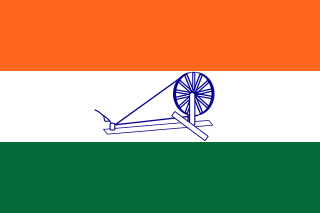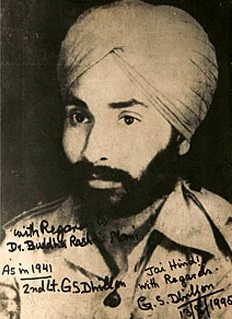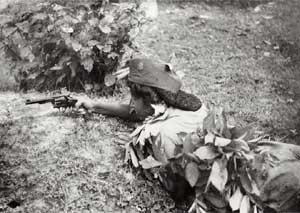
The Indian National Army was an armed force formed by Indian nationalists and Imperial Japan in 1942 in Southeast Asia during World War II. Its aim was to secure Indian independence from British rule. It fought alongside Japanese soldiers in the latter's campaign in the Southeast Asian theatre of WWII. The army was first formed in 1942 under Mohan Singh, by Indian PoWs of the British-Indian Army captured by Japan in the Malayan campaign and at Singapore. This first INA collapsed and was disbanded in December that year after differences between the INA leadership and the Japanese military over its role in Japan's war in Asia. Rash Behari Bose handed over INA to Subhas Chandra Bose. It was revived under the leadership of Subhas Chandra Bose after his arrival in Southeast Asia in 1943. The army was declared to be the army of Bose's Arzi Hukumat-e-Azad Hind. Under Bose's leadership, the INA drew ex-prisoners and thousands of civilian volunteers from the Indian expatriate population in Malaya and Burma. This second INA fought along with the Imperial Japanese Army against the British and Commonwealth forces in the campaigns in Burma: at Imphal and Kohima, and later against the Allied retaking of Burma.

Lakshmi Sahgal was a revolutionary of the Indian independence movement, an officer of the Indian National Army, and the Minister of Women's Affairs in the Azad Hind government. Sahgal is commonly referred to in India as Captain Lakshmi, a reference to her rank when taken prisoner in Burma during the Second World War.

During the Second World War (1939–1945), India was controlled by the United Kingdom, with the British holding territories in India including over six hundred autonomous Princely States; British-occupied India officially declared war on Nazi Germany in September 1939. The British Raj, as part of the Allied Nations, sent over two and a half million soldiers to fight under British command against the Axis powers. The British government borrowed billions of pounds to help finance the war. India also provided the base for American operations in support of China in the China Burma India Theater.

The Provisional Government of Free India or, more simply, Azad Hind, was an Indian provisional government established in Japanese occupied Singapore during World War II. It was created in October 1943 and supported by–as well as largely dependent on–the Empire of Japan.

Gurbaksh Singh Dhillon was an officer in the Indian National Army (INA) who was charged with "waging war against His Majesty the King Emperor". Along with Shah Nawaz Khan and Prem Kumar Sahgal, he was tried at the end of World War II in the INA trials that began on 5 November 1945 at Red Fort. Dhillon also played an important role in the Indian independence negotiations.

Asaf Ali was an Indian independence fighter and noted Indian lawyer. He was the first Indian Ambassador to the United States. He also worked as the Governor of Odisha.

Bhulabhai Desai was an Indian independence activist and acclaimed lawyer. He is well-remembered for his defence of the three Indian National Army soldiers accused of treason during World War II, and for attempting to negotiate a secret power-sharing agreement with Liaquat Ali Khan of the Muslim League.
The Royal Indian Navy revolt encompasses a total strike and subsequent revolt by Indian sailors of the Royal Indian Navy on board ship and shore establishments at Bombay harbour on 18 February 1946. From the initial flashpoint in Bombay, the revolt spread and found support throughout British India, from Karachi to Calcutta, and ultimately came to involve over 20,000 sailors in 78 ships and shore establishments.

Shah Nawaz Khan was an Indian politician who served as an officer in the Indian National Army during World War II. After the war, he was tried, convicted for treason, and sentenced to death in a public court-martial carried out by the British Indian Army. The sentence was commuted by the Commander-in-chief of the Indian Army following unrest and protests in India.

Colonel Prem Kumar Sahgal was an officer of the British Indian Army. After becoming a Japanese prisoner of war, he served as an officer in the Indian National Army, which was led by Subhas Chandra Bose and had been set up by the Japanese ostensibly to fight against British rule in India.

The Indian National Army trials, which are also called the Red Fort trials, were the British Indian trial by courts-martial of a number of officers of the Indian National Army (INA) between November 1945 and May 1946, for charges variously for treason, torture, murder and abetment to murder during World War II. The first, and most famous, of the approximately ten trials held in the Red Fort in Delhi. In total, approximately ten courts-martial were held. The first of these, and the most celebrated one, was the joint court-martial of Colonel Prem Sahgal, Colonel Gurbaksh Singh Dhillon, and Major General Shah Nawaz Khan. The three had been officers in the British Indian Army and were taken as prisoners of war in Malaya, Singapore and Burma. They had, like a large number of other troops and officers of the British Indian Army, joined the Indian National Army and later fought in Imphal and Burma alongside the Japanese forces in allegiance to Azad Hind. These three came to be the only defendants in the INA trials who were charged with "waging war against the King-Emperor" as well as murder and abetment of murder. Those charged later only faced trial for torture and murder or abetment of murder. The trials covered arguments based on Military Law, Constitutional Law, International Law, and Politics. As it was an Army trial, Lt.Col.Horilal Varma Bar At Law & the Then Prime minister of The Rampur State fought the Case along with Mr. Tej Bahadur Sapru to defend the three. These trials attracted much publicity, and public sympathy for the defendants who were considered by some to be patriots of India and fought for the freedom of India from the British Empire. Outcry over the grounds of the trial, as well as a general emerging unease and unrest within the troops of the Raj, ultimately forced the then Army Chief Field Marshal Claude Auchinleck to commute the sentences of the three defendants in the first trial.

The Rani of Jhansi Regiment was the Women's Regiment of the Indian National Army, the armed force formed by Indian nationalists in 1942 in Southeast Asia with the aim of overthrowing the British Raj in colonial India, with Japanese assistance. It was one of the very few all-female combat regiments of the Second World War on any side. Led by Captain Lakshmi Swaminathan, the unit was raised in July 1943 with volunteers from the expatriate Indian population in Southeast Asia. The unit was named the Rani of Jhansi Regiment after Lakshmibai, Rani of Jhansi.
Jiffs was a pejorative term used by British Intelligence, and later the 14th Army, to denote soldiers of the Indian National Army after the failed First Arakan offensive of 1943. The term is derived from the acronym JIFC, short for Japanese-Indian fifth column. It came to be employed in a propaganda offensive in June 1943 within the British Indian Army as a part of the efforts to preserve the loyalty of the Indian troops at Manipur after suffering desertion and losses at Burma during the First Arakan Offensive. After the end of the war, the term "HIFFs" was also used for repatriated troops of the Indian Legion awaiting trial.
The First Indian National Army was the Indian National Army as it existed between February and December 1942. It was formed with Japanese aid and support after the Fall of Singapore and consisted of approximately 12,000 of the 40,000 Indian prisoners of war who were captured either during the Malayan campaign or surrendered at Singapore and was led by Rash Behari Bose. It was formally proclaimed in April 1942 and declared the subordinate military wing of the Indian Independence League in June that year. The unit was dissolved in December 1942 after apprehensions of Japanese motives with regards to the INA led to disagreements and distrust between Mohan Singh and INA leadership on one hand, and the League's leadership, most notably Rash Behari Bose, who handed over the Indian National Army to Subhas Chandra Bose. A large number of the INAs initial volunteers, however, later went on to join the INA in its second incarnation under Subhas Chandra Bose.
The Farrer Park address was an assembly of the surrendered Indian troops of the British Indian Army held at Farrer Park in Singapore on 17 February 1942, two days after the Fall of Singapore. The assembly was marked by a series of three addresses in which the British Malaya Command formally surrendered the Indian troops of the British Indian Army to Major Fujiwara Iwaichi representing the Japanese military authority, followed by transfer of authority by Fujiwara to the command of Mohan Singh, and a subsequent address by Mohan Singh to the gathered troops declaring the formation of the Indian National Army to fight the Raj, asking for volunteers to join the army.
The Battles and Operations involving the Indian National Army during World War II were all fought in the South-East Asian theatre. These range from the earliest deployments of the INA's preceding units in espionage during Malayan Campaign in 1942, through the more substantial commitments during the Japanese Ha Go and U Go offensives in the Upper Burma and Manipur region, to the defensive battles during the Allied Burma Campaign. The INA's brother unit in Europe, the Indische Legion did not see any substantial deployment although some were engaged in Atlantic wall duties, special operations in Persia and Afghanistan, and later a small deployment in Italy. The INA was not considered a significant military threat. However, it was deemed a significant strategic threat especially to the Indian Army, with Wavell describing it as a target of prime importance.
The integral associations of the Indian National Army's history with that of the war in South East Asia, especially the Japanese occupation of South East Asian countries, the renunciations of the oath to the King, as well as war-time propaganda and later allegations of torture by INA soldiers have inspired a number of controversies. Principal among these is the Intelligence propaganda during the war implied alleged torture at a massive scale of Indian and Allied prisoners of war by the INA troops in collaboration with the Japanese.
Habib ur Rahman (1913–1978) was an Indian nationalist during British colonial rule of India, and an officer in the Indian National Army (INA) who was charged with "waging war against His Majesty the King Emperor". He served as Subhas Chandra Bose's chief of staff in Singapore, and accompanied Bose on his last fatal flight from Taipei to Tokyo, sharing the last moments of his life. Rahman also played an important role in the First Kashmir War. Convinced that Maharaja Hari Singh was out to exterminate the Muslims of Jammu and Kashmir, he joined Major General Zaman Kiani, in launching a rebellion against the Maharaja from Gujrat in Pakistani Punjab. Rehman and his volunteer force launched an attack on the Bhimber town. But, the records of the 11th Cavalry of the Pakistan Army indicate that their efforts did not succeed, and eventually the Cavalry was responsible for conquering Bhimber.
The Indian National Army (INA) and its leader Subhash Chandra Bose are popular and emotive topics within India. From the time it came into public perception in India around the time of the Red Fort Trials, it found its way into the works of military historians around the world. It has been the subject of a number of projects, of academic, historical and of popular nature. Some of these are critical of the army, some — especially of the ex-INA men — are biographical or autobiographical, while still others historical and political works, that tell the story of the INA. A large number of these provide analyses of Subhas Chandra Bose and his work with the INA.
The Indian National Army (INA) was an Indian military wing in Southeast Asia, particularly active in Singapore, that was officially formed in April 1942 and disbanded in August 1945. It was formed with the help of the Japanese forces and was made up of roughly about 45 000 Indian POWs, who were captured after the fall of Singapore on 15 February 1942. It was initially formed by Rash Behari Bose and headed till April 1942. Rash Behari Bose handed over INA to Subhas Chandra Bose,atlast the responsibility of leadership fell to Subhas Chandra Bose in 1943.









